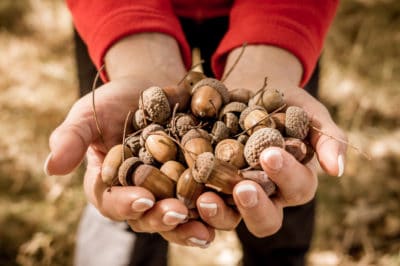Acorn Structure
Most acorns have three distinct parts:
-
- The cupule (cup for short or involucre, in botanical terms) channels nutrients from the tree to the acorn. Its scaly surface provides protection. When the acorn is positioned tip down, the cupule closely resembles a hat.
- The nut is the smooth, hard oblong or oval part beneath or wrapped in the cupule. Inside it is the seed you’d plant to grow an oak.
- The stalk protruding from the top of the cup once attached the acorn to a branch.
Expert gardener’s tip: The acorns of sessile oaks found in Europe and the Middle East have no stalks.
Identifying an Acorn
For an accurate ID, observe and record characteristics of a ripe acorn.
- Measure the acorn from the tip of its base to the point where cup joins the stalk.
- Measure the stalk.
- Observe the shape. Globose acorns are squat and rounded, with blunted tips. Fusiform ones are narrow and oblong, with tapered tips.
- Observe the cup. Does it sit flat like a beret? Or is it more like a glove enveloping the nut?
- Examine the cup’s overlapping scales. Are they thin and flat, like pancakes, or thick and bumpy, like warts?
- Twist the cup off the nut and examine it inside and out for fine or wooly hairs. Not all acorns have them.
- Note the acorn’s color. Ripe ones may be light, dark or reddish-brown — or even black.
- Check around the tree for acorns with seeds sprouting inside their nuts. Acorns belonging to the white oak group sprout in fall. Acorns from the red oak group (which also includes black oaks) drop in fall, but sprout in spring.
Expert gardener’s tip: After recording your observations, rely an illustrated field guide to the oaks in your region to decipher your acorn’s species. For the most accurate results, choose a guide with color photos.
Text:
Artikelbild:
